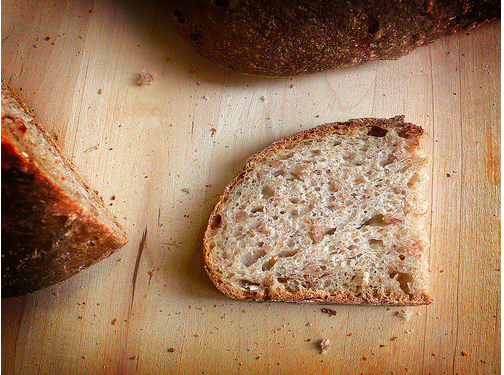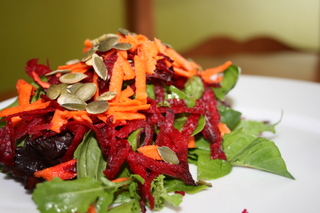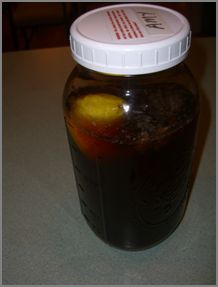 Photo credit
Photo credit
Using whole grains in your cooking/baking is the first and one the most significant step you can take towards improving your nutrition. Whole grains include: whole wheat, kamut, spelt, brown rice, oats, any many others. Unlike white flour, whole grains keep the bran & germ together and in tact, which supplies you with all the nutrients. It is important to note that making the switch to whole grains is easier than you think. In fact, many recipes can be switched white flour with whole wheat flour without any difficulty. But, just because you have or are in the process of switching to healthier grains does not mean you are getting all the nutritional value. Have you ever considered that whole wheat and other whole grains might be very difficult for your body to digest?
Grinding Your Own Flour
Fresh flour contains all the vitamins and minerals missing in commercial flours. It includes the bran which is vital for a healthy colon and weight control. It is economical. Within 24 hours up to 40% of the nutrients have oxidized. In three days up to 80% of nutrients have oxidized, so using freshly grained flours preserves all the wonderful nutrients. Read more benefits here.
I personally use a NutriMill grinder. You can read more about this particular grinder at Pleasant Hill Grain Company online (www.pleasanthillgrain.com). It has worked splendidly for me! They have wonderful customer service as well. This is the one of the best investments you can make towards becoming more healthy and nutritious in your cooking. Check out this article to compare different mills. I store mine on my kitchen counter, because it is small and convenient for easy access. I have ground everything from beans, to grains, to corn in it.
Phytic Acid Prevents Digestion
Unfortunately, whole grains contain phytic acid in the bran of the grain which combines with key minerals, especially calcium, magnesium, copper, iron, and zinc and prevents their absorption in the intestinal tract. This makes it more difficult to digest properly. Soaking, fermenting, or sprouting the grain before cooking or baking will neutralize the phytic acid, releasing these nutrients for absorption.
This process allows enzymes, lactobacilli and other helpful organisms to not only neutralize the phytic acid, but also to break down complex starches, irritating tannins and difficult-to-digest proteins, including gluten. For many, this may lessen their sensitivity or allergic reactions to particular grains. Everyone will benefit, nevertheless, from the release of nutrients and greater ease of digestion.
How to Soak
1. The first stage of preparation is to soak the whole grain flour in an acid medium and liquid. The basic idea is to soak all the flour with the liquid ingredients and 1 Tbsp of an acid medium per cup of water called for in the recipe.
- If the substance is too dry to mix well (i.e. more flour than can mix evenly with the liquids), you can also add the liquid oil and sweetener (honey, maple syrup or agave) called for in the recipe to the mixture. This will help maintain a moist consistency that is easy to combine with the other ingredients after soaking.
- Acid mediums options include: cultured buttermilk, milk kefir, coconut kefir, water kefir, cultured yogurt, whey, lemon juice or apple cider vinegar. Dairy product acid mediums must be cultured!
- Make sure to use warm filtered water/liquids for soaking. Warm water is necessary for the soaking process to be effective. Warm the water/liquids until they are bath water temperature before adding to the grain/flour.
- Brown rice, buckwheat, and millet do not have as high of phytate content and thus need only be soaked for 7 hours (these are great last minute grains if you forget to soak, won’t be a big problem – also recommend purchasing brown rice pasta for this reason as well)
-All other grains (whole wheat, spelt, kamut, oats, etc) should be soaked from 12-24 hours, with oats have the highest level and best soaked for 24 hours.
2. Leave your grains soaking at room temperature on your counter. Cover tightly with plastic wrap, or with a plate to prevent it from drying out (especially in the case of a dough). After soaking, you add the remaining ingredients, if required, and proceed with recipe!
Sue Gregg shares two other benefits to soaking: “There are two other advantages of the two-stage process. Several hours of soaking serves to soften the grain, resulting in baked goods lighter in texture, closer to the texture of white flour. The longer the soaking, the less necessary is baking powder. Baking soda, alone, will give enough rise. Secondly, this is a great step in convenience, dividing the task into two shorter time periods, cutting the time needed to prepare the recipe right before cooking and baking when you feel
rushed to get food on the table.”
Another benefit I have found to soaking is that it absorbs the liquids and expands the grains, making a larger quantity in the end. This is very true especially with my soaking oatmeal. If I forget to soak, it results in a smaller batch, but if I soak it increases the quantity and is more satisfying and filling as well. Soaked baked goods and cereals are always lighter in texture as well, and not dense as their unsoaked wheat counterparts. Don’t quite know why this happens, but it extends the food budget further! Whole grains overall are much more satisfying and fill you up longer than white products…so once again, more value for your money!
Soaking Cereals
Simply soak your cereals in half the quantity of water called for in the recipe with the 1 Tbsp acid medium per cup of water for 12-24 hours. When you are ready to cook, boil the other half of the water before adding the soaked grain. It will be ready in 5 minutes!
For our regular twice a week breakfast of oatmeal, I soak 1 cup of rolled oats with 1 cup of water and 1-2 Tbls of kefir. I let it sit covered overnight. In the morning I put 1 cup of water to boil on the stove. When it is rolling, I add the soaked oats and let it simmer for 5 minutes or so. We then add ground flax seeds, dried cranberries, chopped apples and sometimes a little mashed bananas and there you have an excellent high fiber breakfast.
Soaking Quick Breads
For quick breads (waffles, pancakes, muffins, etc) add 1 Tbsp of an acid medium (best with cultured buttermilk or kefir) for every cup of water called for in the recipe, cover and soak as recommended above. If the recipe calls for buttermilk already, soak in the buttermilk or replace with kefir (which is my favorite!).
I replace buttermilk with kefir completely most of the time without problem. If desired, you can also add all the other liquid ingredients besides the egg, leavenings, and salt in the soaking mixture as well. This helps maintain a moist dough. After soaking, I simply add the egg, leavenings and salt called for in the recipe. Sue Gregg incorporates this idea in all her breakfast recipes. See recipe below. She has other sample recipes on her website.
Whole Grain Pancake/Waffle Recipe – includes instructions on soaking! This is simply delicious!
Soaking Beans
Beans should be rinsed then soaked with 1 Tbsp whey or lemon juice per cup of beans. After soaking, drain, rinse and start with fresh water. Follow the recommended quantities as you would normally.
Soaking Yeast Breads
Soak flour, and 1 Tbsp vinegar or kefir for every cup of water called for in the recipe (leave 1/2 cup of water for activating yeast later). I like to also add the oil and sweeteners to maintain moist dough, otherwise cover tightly with plastic wrap. After soaking, active the yeast in the remaining water with a tsp of honey. Proceed with the recipe.
My Homemade Bread Recipe – with soaking instructions!
Soaking Brown Rice
Combine your rice and all the water called for in the recipe with 1-2 Tbsp of acid medium and let soak for 7 hours. I combine these ingredients in the pot I will cook it in. When ready, simply turn it on and cook as usual. My recipe is to soak 1 cup brown rice to 2 1/4 cup water, with 2 Tbsp of kefir. Heat to boiling and then turn to low heat and simmer for 45 minutes.
For more recipes, view the recipe index. Most of my recipes include soaking instructions.
Soaking is actually quite simple. The key: thinking ahead! Write it in your schedule! Each morning after breakfast and making dinner preparations, I also ask myself if I need to soak anything for the next day. I quickly combine it and let it sit on my counter.
Further Reading
Urban Homemaker articles on Soaking here & here
How I use kefir and the wonderful benefits
Tammy’s Kefir Making Instructions
Two Stage Process - introduction to soaking by Sue Gregg – I drew much of the above information from this article
Sue Gregg’s Breakfast cookbook is my favorite intro to different whole grains and how to include them in your diet. This book shows you how to grind grains in your blender for many morning breakfasts. Works wonderfully!
Be Kind to Your Grains – article by Sally Fallon, author of Nourishing Traditions on why we should soak our grains
Two other good options that accomplish the same benefits as soaking, include using sprouted flour or sourdough methods.





